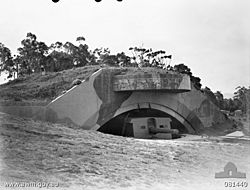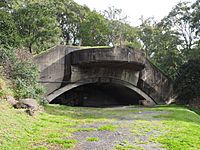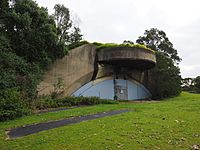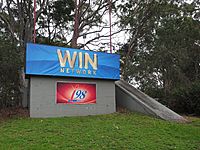Drummond Battery facts for kids
Quick facts for kids Drummond Battery |
|
|---|---|
| Part of Kembla Fortress | |
| Mount Saint Thomas, New South Wales | |

No. 2 BL 9.2 inch gun in 1944
|
|
| Type | Coastal artillery position |
| Site information | |
| Owner | Australian Army (1942-1944) WIN Television (current) |
| Operator | Fort Drummond Mushrooms (1966-1972) |
| Site history | |
| Built | 1942-1943 |
| Built by | Public Works Department and Department of Main Roads |
| In use | 1942-1954? |
| Garrison information | |
| Garrison | 13th Garrison Battalion, 2nd Garrison Battalion, 12th Battalion VDC |
Drummond Battery, also known as Fort Drummond, is an old military fort in Mount Saint Thomas, Wollongong, New South Wales, Australia. It was built between 1942 and 1943. The fort was designed to protect the important industrial area of Port Kembla during World War II.
Today, the site is used by a television station and was once a mushroom farm. It's a heritage-listed site, meaning it's important to history.
Contents
Building Fort Drummond
During World War II, Australia needed to protect its coastlines. Port Kembla was a key industrial area, so it needed strong defences.
Early Fortifications in Port Kembla
Before Fort Drummond, other forts were built nearby.
- Breakwater Battery: Finished in 1939, it was the first fort to defend Port Kembla.
- Illowra Battery: Built in 1942, this fort had tunnels to hide guns and soldiers from air attacks.
- Observation Posts: Special lookout points were set up on hills like Hill 60 and Berkeley Hill to spot enemy ships or planes.
Why Fort Drummond Was Built
Work on Fort Drummond began in 1942. It was built on Mount St Thomas, north-west of Port Kembla. This fort was very important because it would house two massive 9.2-inch guns. These guns were designed to fire far out to sea.
Constructing the Big Guns
Building Fort Drummond was a huge job.
- Workers had to dig out a lot of rock to make space for the gun foundations and underground rooms.
- Two large 9.2-inch guns were installed using big cranes.
- Concrete arches protected the guns from bombs. These arches were covered with grass to hide them from the air.
- Tunnels were dug into the hillside for storing ammunition and housing soldiers.
- A special observation post was built between the two gun positions.
The Names: Mount Drummond and Mount St Thomas
The fort's location, Mount Drummond, was part of land owned by someone named J Drummond. There was some confusion about the name, as another Mount Drummond existed. Mount St Thomas was likely named after Jemina Thomas.
Preparing for War
When Japan joined World War II, Australia quickly improved its defences.
- In December 1941, a secret message ordered more coastal defences for areas like Port Kembla.
- By February 1942, the army began taking over land around Mount Drummond. They set up temporary camps for soldiers.
- A brick house nearby became the headquarters for B Company, 13 Garrison Battalion. It housed up to 90 soldiers.
Getting the Guns to Port Kembla
Two large 9.2-inch guns, originally meant for Darwin, were sent to Port Kembla in March 1942.
- Mount Drummond was chosen as their site.
- The guns were so heavy that the trucks carrying them from Melbourne broke down twice!
- By December 1942, both guns were mounted.
- They were first test-fired on March 15, 1943. The fort was mostly finished by July 1943.
Life at the Fort
By early 1943, the war threat seemed less urgent. Soldiers at Port Kembla focused on protecting the forts. The garrison included the 2nd Australian Garrison Battalion and the 12th Battalion VDC. Maps from 1943 show the fort's defences, including wire and machine gun positions.
The government officially bought the land for Fort Drummond in 1944. By November 1944, Port Kembla was no longer considered a "defended port."
Test Firing the Guns
The guns at Drummond Battery were test-fired three times between 1943 and 1946.
- Before the first test, four houses in the firing line had to be demolished. Their owners received money for this.
- By 1947, many other homeowners asked for money because their houses were damaged by the gun tests.
Post-War Use by the Army
After World War II, the Army continued to use Drummond Battery. For example, the Citizen Military Forces trained there in 1953.
Later Uses of Fort Drummond
Fort Drummond found new uses after its military days.
Fort Drummond Mushrooms
In 1966, a Dutch immigrant named Frank Smith Jnr started a mushroom farm at Fort Drummond. He used the fort's underground areas to grow mushrooms. This farm, called Fort Drummond Mushrooms, operated until 1972. It's the only known example in New South Wales of a fort being used for mushroom farming.
WIN Television
Part of the fort's site is now home to WIN Television. This land was bought in the early 1960s. The TV studios were built on part of the old fort site. The street leading to the battery is even called Television Avenue. These TV facilities are still in use today.
What Drummond Battery Looks Like Now
Drummond Battery was built to be very strong. It was designed with underground areas to protect guns, ammunition, and soldiers. The two 9.2-inch guns were protected by huge concrete structures. The concrete was poured in one go to make it extra strong. The underground complex had its own power, water, and air supply.
The fort was built into the hillside, meaning a lot of rock was removed. The gun positions were covered with reinforced concrete arches and painted to blend in with the landscape.
Most of the buildings that were above ground have been removed. However, some smaller corrugated iron buildings and a larger hip-roofed building (possibly the mess hall) still remain. The main gun emplacements are still largely intact.
As of 2020, there haven't been any efforts to preserve Drummond Battery as a tourist or educational site.
Changes Over Time
The guns were removed from the fort. In 1962, other equipment was also taken away.
Why Fort Drummond is Important
| Fort Drummond | |
|---|---|
| Lua error in Module:Location_map at line 420: attempt to index field 'wikibase' (a nil value). | |
| Location | 1 Television Avenue, Mt Drummond, Mount Saint Thomas, City of Wollongong, New South Wales, Australia |
| Built | 1942–1943 |
| Architect | The plans were prepared in Melbourne |
|
Invalid designation
|
|
| Official name: Fort Drummond / | |
| Type | Local Environmental Plan |
| Designated | / 7 January 2000 |
| Reference no. | 2700709 |
| Site type | Fortification |
| Category | Defence |
| Builders | NSW Public Works Department and NSW Department of Main Roads |
Fort Drummond is a significant reminder of the threat Australia faced during World War II. It was a key part of the coastal defence system built to protect important industrial areas like Port Kembla.
- Historical Importance: It shows how quickly Australia responded to the threat of invasion during World War II. It's one of three coastal batteries that protected the steel works in Port Kembla.
- Community Connection: The site is also linked to the mushroom farming started by Dutch migrants after the war. This is the only known example of a World War II gun fort being used for mushroom farming in New South Wales.
- Unique Features: Fort Drummond is a rare example of a gun fort located within a residential area. No other fort layouts like it have been found. It also shows typical concrete construction methods used during World War II.
Gallery




